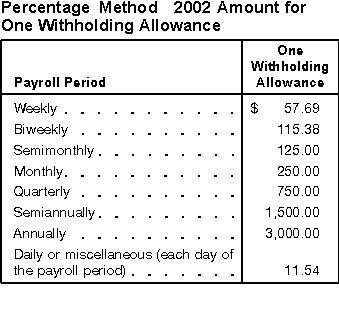There are several methods to figure the income tax withholding for employees. The most common are the wage bracket method and the percentage
method.
Wage Bracket Method
Under the wage bracket method, find the proper table (on pages 22 through 41) for your payroll period and the employee's marital status as shown on
his or her Form W-4. Then, based on the number of withholding allowances claimed on the Form W-4 and the amount of wages, find the amount of tax to
withhold. If your employee is claiming more than 10 withholding allowances, see below.
Note:
If you cannot use the wage bracket tables because wages exceed the amount shown in the last bracket of the table, use the percentage method of
withholding described below. Be sure to reduce wages by the amount of total withholding allowances (shown in the table on this page) before using the
percentage method tables on pages 20 and 21.
Adjusting for employees claiming over 10 withholding allowances.
To adapt the wage bracket tables for employees who are claiming over 10 allowances:
- Multiply the number of withholding allowances that is over 10 by the allowance value for the payroll period. (The allowance values are in
the Percentage Method--2002 Amount for One Withholding Allowance table on this page.)
- Subtract the result from the employee's wages.
- On this amount, find and withhold the tax in the column for 10 allowances.
This is a voluntary method. If you use the wage bracket tables, you may continue to withhold the amount in the "10" column when your employee
has more than 10 allowances, using the method above. You can also use the other methods described below.
Percentage Method
If you do not want to use the wage bracket tables on pages 22 through 41 to figure how much income tax to withhold, you can use the percentage
method based on the table on this page and the appropriate rate table. This method works for any number of withholding allowances the employee claims
and any amount of wages.
Use these steps to figure the income tax to withhold under the percentage method:
- Multiply one withholding allowance (see table on this page) by the number of allowances the employee claims.
- Subtract that amount from the employee's wages.
- Determine the amount to withhold from the appropriate table on page 20 or 21.

Example.
An unmarried employee is paid $600 weekly. This employee has a Form W-4 in effect claiming two withholding allowances. Using the percentage method,
figure the income tax withholding as follows:
| 1. |
Total wage payment |
| $600.00 |
| 2. |
One allowance |
$57.69 |
| 3. |
Allowances claimed on Form W-4 |
2 |
| 4. |
Line 2 times line 3 |
|
115.38 |
| 5. |
Amount subject to withholding (subtract line 4 from line 1) |
|
$484.62 |
| 6. |
Tax to be withheld on $484.62 from Table 1-- single person, page 20 |
|
59.39 |
To figure the income tax to withhold, you may reduce the last digit of the wages to zero, or figure the wages to the nearest dollar.
Annual income tax withholding.
Figure the income tax to withhold on annual wages under the Percentage Method for an annual payroll period. Then prorate the tax back to the
payroll period.
Example.
A married person claims four withholding allowances. She is paid $1,000 a week. Multiply the weekly wages by 52 weeks to figure the annual wage of
$52,000. Subtract $12,000 (the value of four withholding allowances annually) for a balance of $40,000. Using Table 7--Annual Payroll Period, the
annual withholding is $4,432.50. Divide the annual amount by 52. The weekly withholding is $85.24.
Alternative Methods of Income Tax Withholding
Rather than the Percentage or Wage Bracket Methods described above, you can use an alternative method to withhold income tax. Pub. 15-A,
Employer's Supplemental Tax Guide, describes these alternative methods.
Rounding.
If you use the percentage method or alternative methods for income tax withholding, you may round the tax for the pay period to the nearest dollar.
The wage bracket tables are already rounded for you.
If rounding is used, it must be used consistently. Round withheld tax amounts to the nearest whole dollar by (1) dropping amounts under 50 cents
and (2) increasing amounts from 50 to 99 cents to the next higher dollar. For example, $2.30 becomes $2, and $2.80 becomes $3.
Previous | First | Next
Publication Index | 2001 Tax Help Archives | Tax Help Archives | Home

